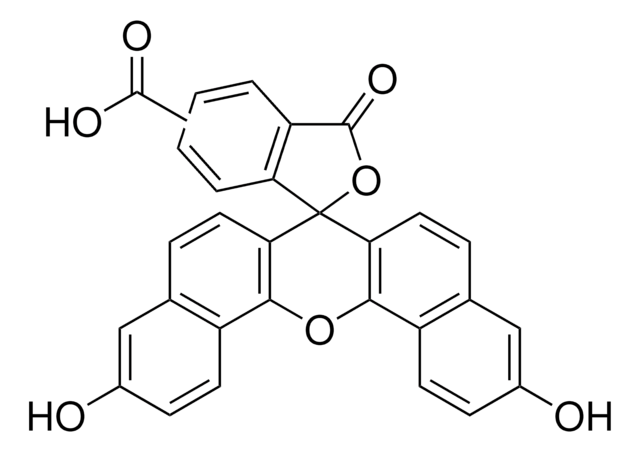21877
5(6)-Carboxyfluorescein
suitable for fluorescence, BioReagent, ≥95% (HPLC)
Synonym(s):
5(6)-FAM, 5,6-CF
About This Item
Recommended Products
product line
BioReagent
Assay
≥95% (HPLC)
form
powder
mp
275 °C (dec.) (lit.)
fluorescence
λex 492 nm; λem 517 nm in 0.1 M Tris pH 8.0
suitability
suitable for fluorescence
SMILES string
OC(=O)c1ccc2c(c1)C(=O)OC23c4ccc(O)cc4Oc5cc(O)ccc35.OC(=O)c6ccc7C(=O)OC8(c9ccc(O)cc9Oc%10cc(O)ccc8%10)c7c6
InChI
1S/2C21H12O7/c22-11-2-5-15-17(8-11)27-18-9-12(23)3-6-16(18)21(15)14-4-1-10(19(24)25)7-13(14)20(26)28-21;22-11-2-5-14-17(8-11)27-18-9-12(23)3-6-15(18)21(14)16-7-10(19(24)25)1-4-13(16)20(26)28-21/h2*1-9,22-23H,(H,24,25)
InChI key
BPVHBBXCESDRKW-UHFFFAOYSA-N
Looking for similar products? Visit Product Comparison Guide
Related Categories
General description
- It has 2 wavelengths for maximum absorbance (465 and 490nm).
- And its fluorescence emission, at 515nm(max.), increases as a function of pH in the physiological range of 6-7.4.
Application
Other Notes
Storage Class Code
11 - Combustible Solids
WGK
WGK 3
Flash Point(F)
Not applicable
Flash Point(C)
Not applicable
Personal Protective Equipment
Certificates of Analysis (COA)
Search for Certificates of Analysis (COA) by entering the products Lot/Batch Number. Lot and Batch Numbers can be found on a product’s label following the words ‘Lot’ or ‘Batch’.
Already Own This Product?
Find documentation for the products that you have recently purchased in the Document Library.
Customers Also Viewed
Articles
Nitric oxide (NO) as a signal transporter in neurons, endothelial cells and in the immune system.
Our team of scientists has experience in all areas of research including Life Science, Material Science, Chemical Synthesis, Chromatography, Analytical and many others.
Contact Technical Service












